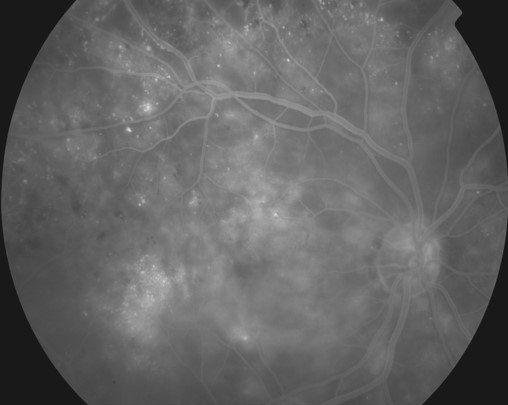EMD is a chronic, progressive complication of diabetic retinopathy in whose pathogenesis VEGF and inflammatory phenomena play a key role. As the disease progresses, the role of inflammation becomes predominant.
First-line therapeutic strategies for the treatment of patients with diabetic macular oedema (EMD) include, according to the most recent guidelines issued by scientific societies
- grid and focal laser photocoagulation, if the EMD does not involve the centre of the macula or if the OCT (optical computed tomography) thickness in the central subfield is less than 400 µm. This technique has for several years represented the gold standard for the management of EMD, however, it has been shown not to be particularly effective in improving visual acuity;
- intravitreal administration of vascular endothelial growth factor receptor antagonists (VEGF,vascular endothelial growth factor), is today the treatment of choice in patients with EMD involving the centre of the macula and resulting in reduced visual acuity. Anti-angiogenic therapy is an effective approach that can lead to an improvement in lost visual acuity. Intravitreal administration of anti-VEGF drugs, however, requires frequent administrations that subject the patient to up to 7-8 injections during the first year and then decrease during the second and third year.
For patients who are not sufficiently responsive to first-line treatment, intravitreal administration of corticosteroids is indicated. This patient population is estimated to be approximately 40% of those treated with anti-VEGF. Patients who do not show an improvement in visual acuity (BCVA, best-corrected visual acuity) of at least 5 letters on the ETDRS scale within a period of about 12 to 16 weeks are considered to be insufficiently responsive to first-line therapy.
What are the new treatment options?
The corticosteroid drugs available to date require multiple annual intravitreal administrations (usually every 4-6 months). Since the beginning of 2017, it has also been available in Italy an installation small intravitreal (3.5 mm in length and 0.37 mm in diameter) capable of releasing a corticosteroid (fluocinolone acetonide) in a controlled and constant manner for 3 years, thus ensuring long-term drug coverage. The implant is fully reimbursable in hospital for patients already undergoing cataract surgery (pseudophakic). The use of this innovative drug delivery results in a significant reduction in the total number of intravitreal injections a patient must undergo over the three-year period (with a reduction in the risk of complications) and a consequent increase in patient adherence to therapy.
What scientific data support the new fluocinolone acetonide intravitreal implant?
The clinical studies that led to the drug's registration in Europe were conducted in patients with EMD already treated with laser. These studies showed that, at the end of 3 years, about one third of patients with persistent EMD (i.e. lasting more than 3 years) treated with the implant containing fluocinolone acetonide had experienced a doubling of their visual acuity (equal to a 15-letter increase in BCVA). At the same time, a rapid and significant reduction in the thickness of the central fovea was observed. These data were also confirmed in real-life studies in patients already treated with anti-VEGF drugs.
 The risks associated with intravitreal injection of fluocinolone acetonide are those typical of corticosteroids, i.e. occurrence of cataracts and increased intraocular pressure. About 30% of the patients included in the registration studies needed topical therapy to control intraocular pressure and about 5% of them needed more aggressive treatment (laser or surgery). In the studies real life only 15-20% of the needed drug therapy for intraocular hypertension and less than 1% needed surgical treatment.
The risks associated with intravitreal injection of fluocinolone acetonide are those typical of corticosteroids, i.e. occurrence of cataracts and increased intraocular pressure. About 30% of the patients included in the registration studies needed topical therapy to control intraocular pressure and about 5% of them needed more aggressive treatment (laser or surgery). In the studies real life only 15-20% of the needed drug therapy for intraocular hypertension and less than 1% needed surgical treatment.
Thus, the availability of this new drug:
- is a valid option, in terms of efficacy and safety, for the treatment of patients with EMD insufficiently controlled with first-line drugs;
- provides a long-term drug coverage thanks to the continuous release of micro-doses of active ingredient;
- reduces the number of intravitreal injections resulting in improvement of quality of life of the patient
Bibliography
- Syed YY. Fluocinolone Acetonide Intravitreal Implant 0.19 mg (ILUVIEN): A Review in Diabetic Macular Edema. 2017 Apr;77(5):575-583.
- Veritti D, Sarao V, Diplotti L, Samassa F, Lanzetta P. Fluocinolone acetonide for the treatment of diabetic macular oedema. Expert Opin Pharmacother. 2017Oct;18(14):1507-1516
- Guidelines for the screening, diagnosis and treatment of diabetic retinopathy in Italy, Working Group on Ocular Complications of Diabetes, Italian Society of Diabetology, 2015.
- Schmidt-Erfurth U, Garcia-Arumi J, Bandello F, Berg K, Chakravarthy U,Gerendas BS, Jonas J, Larsen M, Tadayoni R, Loewenstein A. Guidelines for the Management of Diabetic Macular Edema by the European Society of Retina Specialists (EURETINA). Ophthalmologica. 2017;237(4):185-22
Dr. Carmelo Chines
Direttore responsabile
